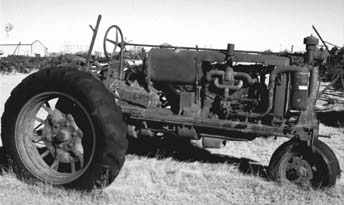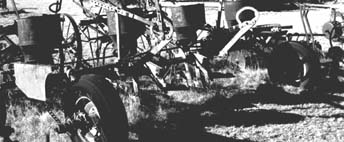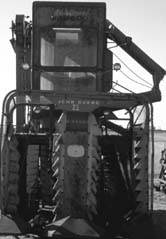Outdated but Still Wanted
|
||||||||||||
A look into
the Hale County Farm and Ranch
|
||||||||||||
 |
by: Jarrod Ross | |||||||||||
|
As our society develops, so
do new techniques and equipment used for farming and ranching. As America grows and changes,
so does agriculture. Not just in the way that farmers and ranchers work,
but technological advancements are sweeping through the agricultural industry. But what happens to this outdated
machinery? Most lay in fields and barns until sold for scrap iron. However, the Hale County Farm
and Ranch Historical Museum’s goal is recording these changes. In 1971, P.L. Pollard called
a meeting to discuss the possibility of forming a farm museum. The project
languished for 10 years, and on July 13, 1981, it received its charter
from the Texas Secretary of State. The Hale County Museum sits
on a five-acre site donated by the Master’s Trust, six grandchildren
of Everett Masters. Masters was one of the museum’s early officers
who pledged his support in 1971. The first building donated
was the Hale Center Santa Fe Depot in 1982. This building symbolizes Hale
Center’s prosperity. As the Santa Fe Railroad spread across the Panhandle,
Hale Center residents discovered the tracks would miss the town by three
miles.
Eight men from Hale Center,
known as "The Dirty Eight," guaranteed the Santa Fe Railroad
$75,000 if the railroad went through Hale Center. By July 1909, the railway
from Plainview to Hale Center had been completed. The Irrigation Building was
donated in 1984 and houses George Green’s machinery. "We call George Green
the father of irrigation," Rieff said. Green revolutionized farming
on the South Plains. He was a qualified pattern maker and draftsman of
the irrigation equipment he designed, manufactured and sold which made
large-scale farming possible in West Texas. Another piece of Hale County
history present at the museum is the Pinkerton House. The house was donated
to the museum in 1985, and five years were spent renovating and furnishing
the house with many of its original pieces of furniture. "Nine children grew up
here," Rieff said. "So within a few years of living on the farm,
the family had outgrown the six-room house." The family added two additional
rooms to the house, but the addition deteriorated before the house was
moved to the museum. In 1997, the Fred Howard family
provided funds for the building of Howard’s collection of restored
equipment. His collection includes tractors, stationary motors and one-row
horse-drawn equipment. All pieces are in good working condition. The J.M. Tye Family donated
the Tye Building in 1998. Tye invented the first three-point mounted grain
drill in North America, which is on display in the museum. "This is the grain drill
that they are still using," Rieff said.
"The men say that this
is the only tractor that they have ever seen with the original cultivator
and planter," Rieff said. Outside there is a large variety
of equipment collected from local farmers. They were chosen for their
historical significance and rarity. For example, a cotton chopper
is a part of the museum’s outdoor collection. "They (farmers) would
plant a whole bushel of seed, I guess; and when the cotton got up a little
ways and started growing good, they saw what their stand was going to
be, and they would run it (cotton chopper) through there and it would
just block that out as it went down the row and make equal spaces of cotton,"
Project Director Henry Rieff said. Also part of the outdoor collection
is a stationary Caterpillar Engine, which was used to pump water for irrigation. "They were good engines,
but they were sure hard to start," Henry Reiff said. Horse-powered hay balers, a
1912 Case Steam Engine, tractors and manure spreaders are just a few pieces
of the unrestored farm equipment present at the museum. The Hale County Farm and Ranch Historical Museum will continue to grow, as does agriculture today. But the items at the museum will be around for years to come reflecting the old way of life enjoyed on the South Plains. |
||||||||||||
 "They
knew that if the train went east, Hale Center would not exist," Museum
Director Elouise Rieff said.
"They
knew that if the train went east, Hale Center would not exist," Museum
Director Elouise Rieff said. Another
interesting piece of machinery is a 1928 Farmall tractor.
Another
interesting piece of machinery is a 1928 Farmall tractor.